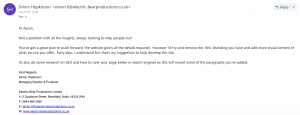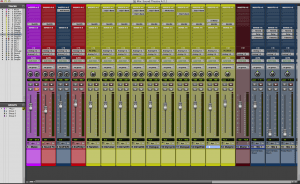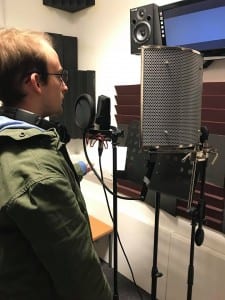This project set out with the overall aim of creating a website that depicted work over the last 5 months. This work would then be showcased to both potential employee’s and industry professionals with the aim of gaining paid work and gaining feedback from industry professionals. Throughout the past 5 months, I and fellow audio production student Ed Richardson have worked on three separate projects with different collections of students each time.
My first learning objective centralized around website marketing, a research section that I wasn’t overly familiar with 4 months ago. An initial challenge in regards to this was determining what method of marketing we would focus on implementing with either; social media marketing or SEO type marketing. I decided to go down the social media marketing route due to the fact we were working with a minimal budget. I believe that overall, I met this aim due to the fact that we have ended up securing future work under the Sound-Ink banner. A main reason for the overall success was conducting primary research into marketing techniques in regards to social media use and overall layout in terms of contact details. This allowed me to create a marketing strategy going forward for the website that focuses on our primary target demography (young directors within the Lincolnshire to Nottinghamshire area), that focuses around the use of social media. We have implemented this strategy somewhat through examples posts within social media pages such as Facebook and Twitter but going foreward we will have to consider the possiblity of using somewhat of an marketing budget for SEO and key words. Another method of feedback we were able to get a hold of was through a local producer called Simon Hopkinson who gave advise in regards to our website in which he declared looking into SEO but again, this is something we will have to revisit when we have somewhat of a budget in place.
My second learning objective focused on working within films groups and improving overall my professional collaboration. To do this I ensured to research various texts into on set etiquette and such. I would also insist on turning up to various meetings with fellow project members as a way of ensuring that I was constantly in the loop with what was currently happening, this proved to be important as it ensured that I was able to obtain various documentation from producers such as sound requirement sheets and testimonials. If we were to redo this project, it might be worth reconsidering how I dealt with project setbacks. For example as opposed to simple okaying setbacks in regards to picture locks being pushed back, it might have been worth me informing the director that whilst this Is fine, it would eat into any spare time we had for potential re-recordings. This would of possibly lead to the directors not pushing back picture locks various times after this.
My final objective was based around using professional mixing and editing techniques to ensure that we presented industry level work to our clients. To do, I initially set out a fair amount of primary research into mixing techniques before devising a 12 step plans in terms of mixing that influenced from an online website entitled SoundTrack. This allowed me to really narrow in on specific sections of research such as Equalisation and Noise Reduction. A lot of the techniques and tips read from The Mixing Engineers Handbook and Audio ProdProcution for Film and Video were used within my post production experience. For example; within Jay Rose’s audio post-production for film and video, he mentions the importance of not spending hours trying to removing a piece of noise that is within a recording unless it is evident that that noise sits within a very specific frequency. Using this mindset allowed me to not go around in circles for hours on end when it came to specific takes within The Way I Am Wired film. Instead of trying to completely rid takes of specific unwanted frequencies, I decided to spend time reducing them down; this meant that the shift in atmosphere wasn’t noticeable overall throughout specific scenes. The fact that we have also received testimonials from both directors shows that they are overall happy with the post-production work that I have done.
Overall, it is clear that a lot of my overall initial learning objectives have been met. In terms of creating content through professional collaboration it is apparent through testimonials from both directors that we were able to achieve this to a very acceptable level that they were pleased with. A reason for the overall success, is that I believe that we maintained a constant level of communication with the directors of all three films projects, assuring that we knew what was happening and when it was happening. In terms of working within post production, it is evident that my main skills still lie within location recording however, although through the use of research I have been able to produce mixes on short films and documentaries that have appeased the directors which shows that I have somewhat developed this skill within the last 4 months of this project. In terms of marketing, I have been able to discover first hand through primary research, how production houses gain and maintain audience interaction. By researching this and taking secondary research about paid for advertising into consideration, I was able to come up with a marketing strategy going forward that will hopefully allow us to grow as a company.


